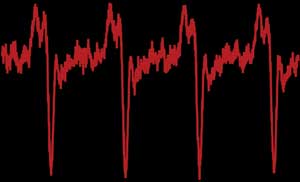Sep 9 2010
Researchers from the University of Colorado at Boulder, and the National Institute of Standards and Technology (NIST) have developed dark pulse lasers.
 The colorized trace showing the light output from a dark pulse laser
The colorized trace showing the light output from a dark pulse laser
The laser device produces a steady light beam with periodic dips, which resembles dark pulses in a continuous bright background. The dark pulse lasers have some possible telecom applications, due to the absence of linearity and dispersion during the dark pulses transmission.
The researcher team was led by Steven T. Cundiff, a physicist at NIST. The researchers fabricated the laser system in a semiconductor cleanroom, by burying a quantum dot made of indium gallium arsenide in the center of a gallium arsenide ridge waveguide, which is 5mm in length. The waveguide was used as the gain medium.
The research team damaged the semiconductor wells of a material, which was grown through molecular beam epitaxy, and thus developed a saturable absorbing medium. This optical properties and positioning of the medium make it to act as an end mirror for the laser cavity. When the components are aligned carefully, a lasing action can be started by injecting 60 mA current into the laser device. The resulting output was the dark pulse lasers. The team obtained short 90-ps duration dark pulses, which can have laser intensity as low as 30% to that of a normal steady-state output.
Simulation results indicated that a saturable absorber, positioned at the end of the laser device, shapes the quantum dot dark pulse. This can allow easier pulse tailoring for a particular application.
Cundiff stated that the quantum dot dark pulse method offers a wide range of wavelengths, smaller size, and higher efficiency than dark pulse fiber lasers. He added that the team will focus on developing mode-locked quantum dot diode lasers, instead of research on dark pulse lasers.